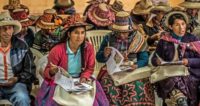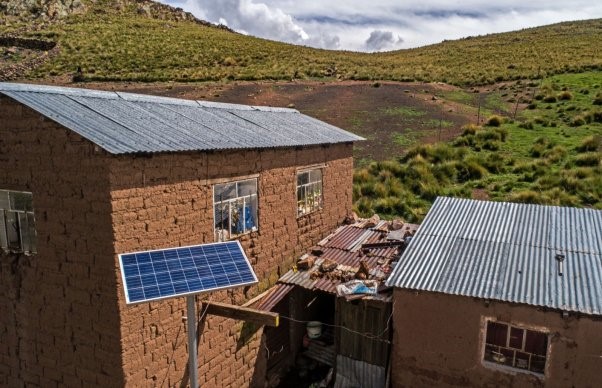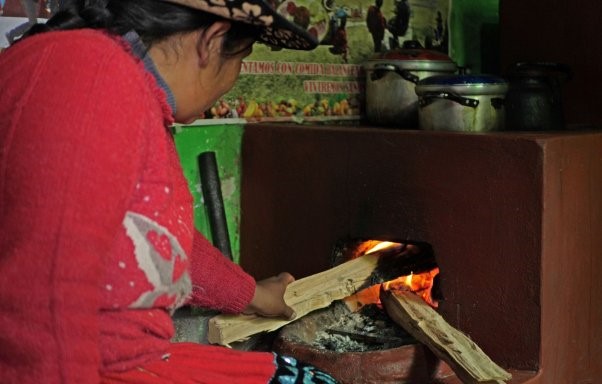Clean energy school for women is transforming their lives
Clean energy school for women is transforming their lives
In Peru’s remote areas, the country's first energy school for women and installation of solar panels are improving quality of life and equipping women to lead change in their communities. Sally Jabiel reports.
Above: Students in the first classes at eMujer (eWomen in English) in Quiñota, where they learned about the benefits of energy-efficient stoves which they now have at home (courtesy MINEM-UNDP-GEF).
There has never been electricity in Cayachira. Located in the plateau region of Puno, about 1200 kilometres from Lima, the capital of Peru, charging a cell phone was a privilege. The inhabitants of this community had to go to the nearest town to access electricity at a store where they also bought batteries and candles to use at night.
This changed a few months ago with the installation of solar panels. It is the women studying at eMujer, the first ‘School of Energy’ for women in the country, who will take the lead in increasing accessibility of this technology to more people in the community.
For people living in remote areas of Peru, such as Cayachira, accessing electricity is often a challenge. Almost two million people still do not have access to electricity in this country and the government has set the goal of installing 200 000 solar panels by 2019. Although ambitious, this goal responds to global advances in electrification. According to the latest Progress Report on Energy (Sustainable Development Goal 7), the number of people without access to electricity in the world decreased from 1 billion in 2016 to 840 million in 2017. This progress is being reflected in the rural parts of Peru.
“We weren’t able to charge our phones before. We had to travel far to buy candles and charge our mobiles. Now it feels like I’m living in an (urban) village and this has improved my life considerably”, says Lucila Choque, a farmer from Cayachira who has one of the solar panels from Peru’s Rural Electrification Programme installed in her home.
However, to ensure that women like Lucila benefit from this access to energy much more is required than just providing electricity. For this reason the Energy School for Women (a pilot launched by the Ministry of Energy and Mines of Peru in partnership with the United Nations Development Program (UNDP) and within the framework of the National Appropriate Mitigation Actions Project (NAMA) in the sectors of power generation and its final use), is training rural women as technicians and entrepreneurs for cleaner energy technologies such as photovoltaic systems and improved cook stoves.
The training at this innovative school consists of three modules that teach women a range of skills from how to use improved cook stoves and solar panels, to construction or installation of these technologies and how to set up a new business.
To ensure accessibility the mobile school sets up in a rural area on mutually agreed upon dates. The school provides translation into native languages such as Quechua and Aymara and activities are arranged for childcare. As such, eMujer provides a unique opportunity for women to be empowered to take the lead in closing the energy gap and clean-cooking gap in the country.
Solar power
Lucila, who is studying the first module at the school in Limón Verde (a village close to Cayachira), says: “I have learned how to look after my panel, to maintain the battery and also how to clean it.”
In this module, Lucila and other women learned how to efficiently use the photovoltaic system that the Government of Peru installed in homes in their community, as well as learning about the energy capacity they have for cell phones, radios and televisions.
In optimal conditions, each photovoltaic panel can provide enough power for Cayachira’s families to have about eight hours of uninterrupted light and up to about seven hours of television or ten hours of radio per day. This access to energy, therefore, has a positive impact on people’s time - particularly on women’s time efficiency.
With electricity, women can work during the day, inside or outside the home, and study at night. They can stay informed through communication devices and participate in other activities in their community. Whereas, without access to electricity, due to their traditional roles at home, it is women who spend several hours a day collecting materials to use as fuel. Moreover, this energy poverty can impact negatively on their health.
Lack of electricity at health centres prevents many pregnant women around the world from receiving medical care that can save their lives. The World Health Organization (WHO) estimates that every year about 287,000 women die from complications during pregnancy and childbirth - mostly in rural areas. Many of these fatalities could be avoided through adequate health services.
Rural electrification has the potential to reduce the burden on women's time through increasing daylight hours, in turn providing greater flexibility to be able to do other activities and above all, guarantee their safety. This emphasises the importance of universal access to energy and gender equality which constitute two of the 17 Sustainable Development Goals (SDGs).
While SDG7 aims “to guarantee universal access to affordable, reliable and modern energy,” it is deeply connected to SDG5, which aims to achieve gender equality and empowerment of all women. Women dedicate more hours to housework, unpaid labour and Peruvian women spend approximately 23 more hours per week on unpaid labour than men, according to a recent report by the National Institute of Statistics and Informatics (INEI). It is clear that access to energy, when inclusive, has a transformative effect on women.
Aligned with the SDGs, the school for women follows a methodology of “learning by doing”. At eMujer each student is an agent of their own learning, an approach with benefits which go beyond the technical aspects of sustainable energies.
Above: Solar panels in Cayachira that the Government of Peru has installed in a move towards closing the energy gap (courtesy MINEM-UNDP-GEF)
In order for women to disseminate the newly acquired knowledge in their communities, the training addresses gender inequalities and environmental problems through reflective processes. Through this, women can empower themselves to take on more active roles in their communities on the path towards access to cleaner energies.
Magnelly Paucará, who has completed the second module at the school in Cayachira, says that "after the training, we can buy the equipment and organise to install solar panels for people who still do not have electricity in their homes." Whilse empowering women like Magnelly will contribute to closing the energy gap, it will also begin closing the gender gap.
In fact, the International Renewable Energy Agency (IRENA) has reported that the renewable energy sector already employs 11 million people globally, of which 32% are women. This far exceeds the 10% of female workers employed in fossil fuels such as oil and gas. This is vital if one considers that, according to the same projections, the number of jobs for this emerging sector could increase from 10.3 million in 2017 to almost 29 million in 2050.
"We hope that women can see the potential that this new (photovoltaic) system can provide. Trade is growing and 12-volt systems are being installed in the most remote areas," says Rommel Cáceres, head of community relations at Ergon, the company in charge of installing the photovoltaic systems in the country's rural electrification program.
A goal of the school is for rural women to set up businesses. A sister organisation in Africa called Solar Sister has the same objective. It is a social enterprise that follows a sales model with more than 1,000 women traveling door-to-door in their communities offering solar devices. The last module at the eMujer school provides Cayachira graduates with training on how to follow a similar business model that also includes technical installation, repair and maintenance of services.
Cooking for equality
Unlike Cayachira, rather than setting up businesses, the women of Quiñota are for now thinking about changing their reality. This change began with the improved cooking stoves that were installed in the rural district of Cusco as part of the national goal of half a million kitchens for cleaner cooking.
Three years ago, Hermelinda Romero was one of the 3,000 million people around the world who, according to the WHO, still use large amounts of fuels such as firewood and coal to cook, heat and light their home. She recalls that ‘when we cooked everything was black on the walls. We blew and the dust went into the pots and made the water dirty. The smoke got in our lungs and made our eyes red, it made us cry.’
Hermelinda, like the other women in Quiñota, is responsible for cooking for her family, which she used to do in a wood stove. According to IRENA, for this type of cooking a woman can spend 100 hours per year collecting firewood. In Quiñota, a stove consumes approximately 50% more wood than an ICS and at the same time produces toxic smoke inside the homes.
"Women breathed smoke, coughed and went to the doctor to ask what was wrong. Smoke is a silent killer," explains Teresa Aquino, a trainer at the eMujer school in that district where pollution inside homes causes serious respiratory and heart disease such as pneumonia, strokes, and even lung cancer.
According to WHO figures this pollution causes approximately 3.8 million premature deaths each year worldwide, mainly among women and children who are more exposed to smoke emitted by firewood and coal in the home. In addition, there is the negative impact on the environment from the greenhouse gas emission from traditional stoves.
"These women recognise how climate change has been affecting them and are aware that these stoves will contribute to reducing greenhouse gases," explains Teresa.
The new stoves release smoke outside of the house through chimneys, and when well-managed, they reduce the amount of toxic air in the house.
Above: Hermelinda Romero is one of the women who has an improved cooking stove at home. This technology reduces wood consumption by up to 50% (courtesy MINEM-UNDP-GEF).
“We want to improve more, change our whole way of life,” says Hermelinda, who completed the first module at the eMujer school in Quiñota. “Until today I had never cleaned my fireplace. I never used to clean out the ashes in my stove because there needed to be enough ash to blow. Today I learned that this is not the case." Sixty people attended the first module, more than expected for a school designed for 25 students per session. Although they were mostly women, the desire to learn even reached some men in the district.
“People are interested in learning about this topic. The course is developed in an interactive way that draws on people’s previous knowledge which is shared and strengthened here," says Teresa. Beyond the environmental and health benefits of improved cooking, students learn that clean-cooking can change their lives when there is equality. And that for this change to be sustainable, the prevailing gender inequalities must be overcome in the entire population of Quiñota.
Men also attended some of the courses at the school where they learn about gender equality and climate change. "Now I cook myself, and my sons and my daughters cook. It’s not only my wife who cooks. We all cook. Now we understand gender equality, we value this, and we will sustain it," says San José Alvarez, a farmer who attended the same classes as Hermelinda and who now understands that cooking is not just a woman's responsibility. That is the legacy of equality that the school is already leaving in Quiñota. A stove is only ‘improved’ when it benefits everyone equally.
A Future with women
It is likely that the number of participants will drop in the following modules which are more specialised and provide training on stove construction and solar panel installation, as well as developing business plans. There are likely to be fewer and fewer attendees because not everyone’s goals and needs necessarily include making a livelihood out of sustainable energy. Nevertheless, for every woman at the school who begins to promote cleaner alternatives in their communities, the future of sustainable energy will be set into motion.
Closing the energy gap does not only depend on the political will to deliver energy to the most remote areas of the country, but also on women being empowered to take advantage of the opportunities provided through clean energy and to become agents of the change.
This is happening in Quiñota, Cayachira and other communities that have realised that women have the potential to facilitate the transition to cleaner energies as well as to learn how to efficiently make use of the technologies, to maintain them and above all, to set up their own businesses so that they can bring these technologies to others.
It is through involving women in providing energy solutions that change will spread to more communities. EMujer is not about women against men but about equality, a prerequisite for change to be able to reach the last person without access to electricity, so that turning on the light is no longer considered to be a privilege.
This report forms part of a partnership between ActionLac (coordinated by Fundación Avina) and LatinClima (supported by Cooperación Española (AECID) via its ARAUCLIMA programme). The report aims to promote journalistic coverage of climate action in Latin America.



